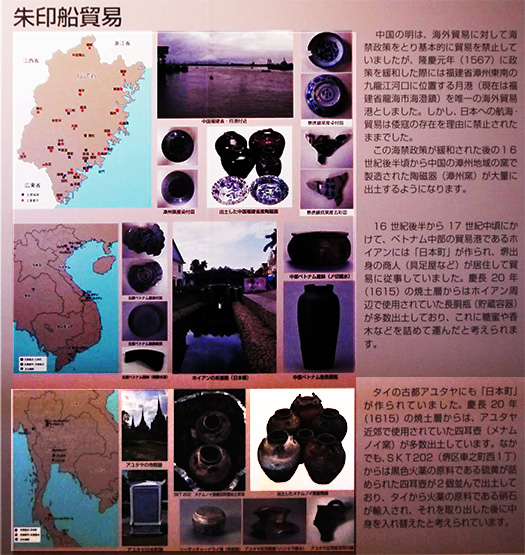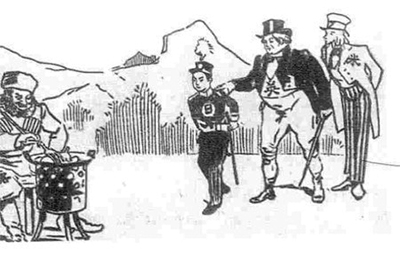

徳川幕府が成立してしばらくの間、キリスト教という政治的波乱因子がありつつ、
大航海時代の世界的貿易ネットワークの一端に日本はあった。
先日の屏風絵で見たように鎖国前には、徳川幕府体制下でも西洋人が堺の町を
ごくふつうに闊歩していた様子がわかる。
日本の貿易活動は遣隋使、遣唐使の時代から主に東アジア世界で
中国・朝鮮の国々や東南アジア諸国との間でさかんに行われていた。
茶の湯の茶葉自体が中国からはじめは禅宗ネットワークで日本に導入された。
本格的には鎌倉時代から禅宗が広く行き渡ると並行して
喫茶の習慣も日本に根付いていくことになるけれど、
この戦国期末期〜江戸時代初期では境の町衆が茶の湯文化の頂点を形成した。
「唐物」という茶器や掛け軸、茶道具などが貿易による利潤の象徴として
堺衆の交易事業者に保有され、珍重する文化として茶の湯があったと思える。
そういう現実の利潤追求の姿勢から精神のバランスを取るように
茶の湯ではことさらに「わび・さび」というような心象を尊しとした。
現実のビジネスの世界では旺盛に利潤追求を徹底したのが当然でしょう。
利休、という号には単純に伝わってくるものがあると思えますね。
伝統的な東アジア貿易に加えてポルトガル・スペインとの交易で
堺はその中核的位置を占めるに至っていた。
偶然に鉄砲が日本にもたらされたと考えるのは性善説すぎるのではないか。
西欧世界にとってみれば、世界制覇のなかで中国という巨大市場に対して
その征服を当然考えたに違いなく、そのための軍事力をどう考えるべきか、
まさか、1年以上の航海を経て西欧から直接軍隊派遣は難しかっただろう。
示威的には考えたにしても、ふつうの戦略眼で考えれば、
東アジアの民族同士で戦わせて現状変更の機会を作り出し、
その過程で自分たちに有利な極東情勢を作り出すことを企図するのが自然。
そういう変化を生み出す可能性をもった国として日本は想定されただろう。
鉄砲の導入によって急速に国内の戦乱状態は統一に向かい、
そして蓄積された軍事パワーの向かう先として、当然半島から大陸への進出が
気運として盛り上がっていっただろうことは想像に難くない。
西欧キリスト教諸国、大航海時代にあったかれらにとって
東アジア世界の中で可能性の高い軍事力国家として日本を考えることは当然と思われる。
秀吉の対中国侵略戦争の企画自体、そういう国際関係の脈絡と考える説もある。
遙かな後世、日清日露とうち続いた時代、西欧での風刺画での「火中のクリ」。

日本は一度、大航海時代に明治開国と同様の体験をしていたのだと思う。
鎖国というのはひとつの「平和」戦略ではあったけれど、
結局200年後、開国から再度、このような世界戦略構図の中に放り出された。
遅かれ早かれ、東洋と西洋の中間的な地政学位置として日本はあり続けていた。
大航海時代の世界の息吹、その痕跡としての茶の湯文化など、
堺の町にはたくさんのミッシングリンクがあるのだと思う。
English version⬇
[Free trade in the Age of Discovery / Special edition of Japanese good houses ㊱-9]
For a while after the establishment of the Tokugawa Shogunate, while there was a political upheaval factor called Christianity,
Japan was part of the global trade network of the Age of Discovery.
As you saw in the folding screen picture the other day, before the isolation of the country, Westerners visited the town of Sakai even under the Tokugawa Shogunate system.
You can see how he was walking normally.
Japan’s trade activities have been mainly in the East Asian world since the days of envoys to Sui and Tang.
It was actively held with the countries of China and Korea and Southeast Asian countries.
The tea ceremony leaves of Chanoyu were first introduced in Japan through the Zen Buddhism network from China.
In earnest, in parallel with the widespread use of Zen Buddhism since the Kamakura period
The habit of coffee will take root in Japan,
From the end of the Warring States period to the beginning of the Edo period, the townspeople on the border formed the pinnacle of the tea ceremony culture.
Tea utensils, hanging scrolls, and tea utensils called “karamono” are symbols of profit from trade.
It seems that the tea ceremony was owned by the Sakai people’s traders and was a prized culture.
To balance the spirit from such an attitude of pursuing profits in reality
At the tea ceremony, the image of “wabi-sabi” was even more respected.
In the real world of business, it is natural that we have been vigorously pursuing profits.
I think that the issue of Rikyu simply conveys something.
In addition to traditional East Asian trade, trade with Portugal and Spain
Sakai has come to occupy its core position.
Isn’t it too good to think that a gun was accidentally brought to Japan?
For the Western world, in the midst of world domination, against the huge market of China
You must have thought about the conquest, and what should you think about the military power for that?
No way, it would have been difficult to dispatch troops directly from Western Europe after more than a year of voyage.
Even if you think about it demonstratively, if you think about it from a normal strategic point of view,
Create opportunities to change the status quo by fighting between East Asian peoples,
In the process, it is natural to plan to create a situation in the Far East that is advantageous to them.
Japan would have been envisioned as a country with the potential to make such changes.
With the introduction of guns, the domestic war situation rapidly became unified,
And, of course, the expansion from the peninsula to the continent is the destination of the accumulated military power.
It’s not hard to imagine that it would have been exciting.
Western Christian countries, for those who were in the Age of Discovery
It seems natural to think of Japan as a military power nation with high potential in the East Asian world.
There is also a theory that Hideyoshi’s plan for the war of aggression against China itself is considered to be the connection of such international affairs.
“Chestnut in the fire” in a caricature in Western Europe, a time that continued with the far posterity, the Sino-Japanese and Russo-Japanese.
I think Japan once had the same experience as the opening of the Meiji era during the Age of Discovery.
Sakoku was a “peace” strategy, but
After all, 200 years later, he was thrown into such a global strategic composition again from the opening of the country.
Sooner or later, Japan continued to exist as an intermediate geopolitical position between the East and the West.
The breath of the world during the Age of Discovery, the tea ceremony culture as a trace of it, etc.
I think there are many missing links in the town of Sakai.
Posted on 7月 14th, 2021 by 三木 奎吾
Filed under: 住宅マーケティング, 日本社会・文化研究







コメントを投稿
「※誹謗中傷や、悪意のある書き込み、営利目的などのコメントを防ぐために、投稿された全てのコメントは一時的に保留されますのでご了承ください。」
You must be logged in to post a comment.